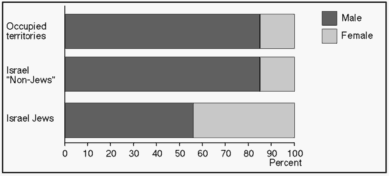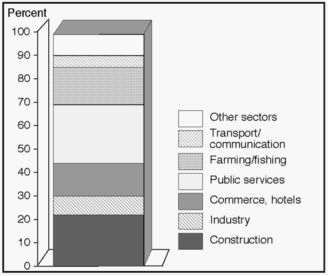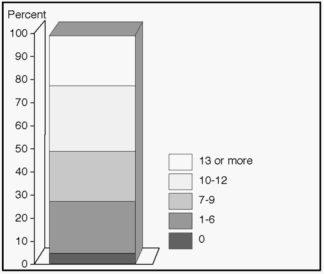
|
||||||||||||||||||||||||||||||||||||||||
Use of the Labour Force in the Occupied TerritoriesWhereas the first main section of this chapter has discussed under-utilization of labour and its different manifestations, by contrast, the focal point of the second part of the chapter will be the labour force members and employed persons residing in the occupied territories34. Several questions will be raised: 1) What are the specific gender, age and educational background characteristics of labour force members residing in the occupied territories, as compared to e.g. "non-Jews" and Jews in the Israeli labour force? 2) Which labour markets are available to workers from the occupied territories? 3) What are the employment characteristics of persons residing in the occupied territories? 4) Who works in Israel, and how do working conditions in Israel compare with those in the occupied territories? 5) What are the employment and background characteristics of female labour force members residing in the occupied territories, specifically in comparison with the male majority?
Background Characteristics of Labour
Figure 7.10 Comparative composition of labour force in the occupied territories and Israel, by gender Figures 7.10, 7.11 and 7.12 show comparative distributions between the three labour force groups by gender, age and education. There seem to be greater similarities between the composition of the labour force in the occupied territories and "non-Jews" in the Israeli labour force, than there are between the latter group and Jews in the Israeli labour force. Compared to Jews in the Israeli labour force, the labour force of the occupied territories is more male dominated, younger and less educated36. Both the compact majority of males as well as the young age structure can be found in most Middle Eastern countries. The labour force of the occupied territories is, however, probably better educated than it is in the neighbouring countries.
Figure 7.11 Comparative composition of labour force in the occupied territories and Israel, by age Within the occupied territories there are relatively small regional differences in the composition of the labour force by gender, age and education. The Gaza labour force is slightly more male dominated and younger than the one in the West Bank and Arab Jerusalem. The labour force in Arab Jerusalem, comprises somewhat more women, older and well educated persons than does the average total for the occupied territories.
Figure 7.12 Comparative composition of labour force in the occupied territories and Israel, by education Variations in labour force participation among different socio-economic groups have already been discussed in the first part of this chapter. Of particular interest, in addition to the significant under-representation of women in the labour force, is the low number of workers employed in Gaza compared to Gaza's share of the total population. The relatively low number of labour force members in Gaza is caused by the existence of a younger population and a lower labour force participation ratio both for men and women in working age. The low number of persons employed in Gaza is thus a product of both a generally low labour force participation ratio and a higher share of participation in the Israeli labour market than for the other regions. The next subsection outlines some assumptions about characteristics of different labour markets available to workers residing in the occupied territories. The section is non-empirical and is primarily intended as an introduction to the section about the distribution of employment on type of work and economic activity.
Available Labour Markets for Workers from the Occupied Territories
Figure 7.13 Graphic presentation of labour markets for men: The labour markets for workers from the occupied territories are clearly marked by segmentation: 1) Israeli authorities have introduced legal restrictions on movement inside the occupied territories and on entry into Israel. 2) Cultural factors, i.e. social customs specifically pertinent to female labour activity, split up the labour market in separate male and female spheres. 3) Several types of jobs are in practice restricted to the family members of businessmen, and shop- or landowners. 4) As in other societies, many jobs require formal education or certificates. 5) Geographical distance, particularly when accompanied by restrictions on movement, sub-divide the occupied territories into regional labour markets37. The overall result of the strong labour market segmentation is low mobility of workers, (in theory) allowing large wage differentials to be upheld. Figure 7.13 presents an overview of assumptions about main types of labour markets available to men residing in the occupied territories, and figure 7.14 some assumptions about characteristics of these markets with regard to entry threshold, wage stipulation and job stability for workers in these markets. (Female labour activity will be further discussed at the end of this section).
Figure 7.14 Characteristics of labour markets for workers from the occupied territories
Employment Characteristics of the Labour Force from the Occupied Territories38
Figure 7.15 Labour force composition by main type of work previous year The distribution of the labour force by type of work and economic activity to some extent reflects the employment characteristics of Palestinian workers in Israel, e.g. the relatively high number of persons holding service and other unskilled jobs. Regional differences according to region of residence are generally small.
Figure 7.16 Labour force composition by main economic branch of work previous year The most important lines of work are construction, public services and various commercial enterprises, (commerce, restaurants, hotels, etc.). It transpires that only 15% of the labour force in the occupied territories are employed in agriculture and fisheries. In most developing countries this share exceeds 50%39. The exceptionally low share of the labour force in the occupied territories engaged in primary industries is mainly an effect of the Palestinian exodus in 1948, which turned peasants into landless refugees. Since 1967 interaction with the Israeli economy has further reduced the role of agriculture. Work stability may be expressed both in terms of number of jobs and number of weeks worked during a fixed time period. Data analysis shows that work stability among labour force members is relatively high with regard to the number of jobs, but low with regard to intensity of work. Four out of five workers have had only one job during the last year (i.e. the last year prior to the survey). Going two years back, the share of workers having had only one job drops to three out of four. Work stability measured as intensity of work shows that one out of three workers has worked only 4 weeks or less during the last two months prior to the survey. Job stability is lower in Gaza than in other regions, particularly with respect to intensity of work40. A comparison of figures 7.15 and 7.17 reveals an apparent gap between education of workers, and their actual type of work.
Figure 7.17 Male labour force members by years of education Even if half of the labour force has 10 or more years of education, figures reveal that only 15% hold high and mid-professional jobs. We will now continue with a discussion of differences between employment in Israel and employment in the occupied territories.
Workers from the Occupied Territories Employed in Israel: A Short Historical
Overview Israeli authorities maintain that there is no formal discrimination against Palestinian workers in the Israeli labour market except for reasons of state security. Palestinian workers are banned from employment in strategic Israeli industries situated both in Israel and the occupied territories42. A complicated system for payment and issuing permits for Palestinians workers is practised43. To work legally in Israel, residents of the occupied territories must hold up to four cards. The person in question must also not hold a so-called "Green Card"44. Permits are issued only after a considerable amount of time involving bureaucratic processing, and after taxes have been paid. No permits are usually required for women and persons below 16 years of age. Very few women from the occupied territories choose to work in Israel, however, this being due to lack of acceptance in the local Palestinian community.
Figure 7.18 Labour force composition by main place of work previous year
Workers from the Occupied Territories Employed in Israel: Socio-economic
Groups45
Figure 7.19 Labour force members in Gaza and the West Bank by main place of work previous year As illustrated by figure 7.19, employment in Israel is especially important in Gaza where 38% of labour force members have their main employment in Israel. In the West Bank and Arab Jerusalem the ratios of the labour force employed in Israel are 25% and 20% respectively47.
Figure 7.20 Main place of work previous year of labour force members in Gaza and the West Bank by type of locality Within the West Bank area there are small geographical variations with regard to employment in Israel. Figure 7.20 shows that the share of the labour force employed in Israel is higher in rural than in urban areas. This result illustrates the post-1967 transformation of the rural labour force from peasants to wage-labourers in Israel. Figure 7.20 shows that the northern part of Gaza sends more workers to Israel than the southern part, which is most likely caused by the relative proximity of the former to major Israeli urban centres. Looking at Gaza and the West Bank separately, it comes to light that camp refugees have a slightly lower ratio of employment in Israel than refugees outside camps and the non-refugee population. The effect of refugee status on employment in Israel is thus contrary to what could have been expected, taking the shortage of alternative employment in the refugee camps into consideration. Attitudes among Palestinian workers towards work in Israel seem to be marked by ambivalence and a sense of unease. On the one hand, work in Israel may be viewed as humiliating and insecure. On the other hand, the Israeli labour market offers employment for deprived groups of landless, poor and rural residents who have few alternative means of employment48. Figure 7.21 show how employment in Israel increases in the group containing the poorest households.
Figure 7.21 Main place of work previous year of labour force members in Gaza and the West Bank by household wealth Figure 7.22 finally illustrates how employment in Israel decreases with increasing age49. The share of employment in Israel among the oldest age group is, as could be foreseen, very low on account of the physical strains put on workers, who usually both have to wait at the border checkpoints and endure tiresome travel to their Israeli work sites50.
Figure 7.22 Main place of work previous year of labour force members by age The effect of education on employment in Israel is somewhat ambiguous. In Gaza, the share of workers employed in Israel decreases with increasing education. In the West Bank, there is a weak tendency to the opposite effect. Most likely higher education among younger than older persons plays a significant role in creating the pattern of behaviour. For the most highly educated group the share of employment in Israel is low, reflecting the status and aspirations among these persons with respect to place of work.
Workers from the Occupied Territories Employed in Israel:
Figure 7.23 Employed persons in the occupied territories and Israel, by gender Figure 7.23 shows that almost all workers from the occupied territories employed in Israel are male. The gender composition of employed persons working in the occupied territories is almost exactly the same as that of employed "Non-Jews" residing in Israel.
Figure 7.24 Employed persons in the occupied territories and Israel, by type of work The distribution of workers from the occupied territories employed in Israel with regard to type of work is very different from the one found for the other three groups. As to type of employment in the occupied territories, workers from the occupied territories employed in Israel hold more vocational, service and other unskilled jobs. The composition of types of work for workers from the occupied territories employed in Israel and for Israeli Jews respectively, are almost inverse. Figure 7.24 shows that hardly any Jews hold unskilled jobs, while the majority conduct various professional work.
Figure 7.25 Employed persons in the occupied territories and Israel, by economic branch
Figure 7.25 illustrates the distribution of the four groups by sector of
work. The dominating economic activity for workers from the occupied territories
employed in Israel is construction, followed by agriculture, public services
and industry. While 64% of the workers are employed in construction and
agriculture/ fishing, only 7% of Israeli Jews hold jobs in these branches.
Figure 7.26 Job stability of employed persons in the occupied territories measured by number of jobs over previous year and main place of work
Figure 7.27 Job stability of employed persons in the occupied territories measured by number of working weeks over previous two months and main place of work As illustrated by Figure 7.28, long and burdensome daily travel constitutes the most significant difference between employment in Israel and employment in the occupied territories53. Transportation to work sites in Israel not only causes long working hours, but may also consume a substantial share of a worker's salary54.
Figure 7.28 Daily two-way travel time to place of work of employed persons in the occupied territories measured by number of working weeks over previous two months and main place of work For all variables discussed in this chapter variations among labour force members from the occupied territories are seen to be larger when it comes to place of work (Israel/O.T) than area of residence (Gaza/WB/AJ). Workers from Gaza, however, exhibit less job stability and experience longer travelling time than workers from other regions do, both when employed in their area of residence and in Israel. In total, workers from the occupied territories constitute only 7% of all persons employed in Israel55. As shown above, their contribution is, however, important in some economic sectors, particularly in construction. The observed differences in employment characteristics between groups may support a hypothesis that the Israeli labour market is organized by ethnic groups. As stated by Semyonov & Lewin-Epstein: "Subordinate ethnic groups are over-represented in marginal industries and in less desirable low-status occupations"56. The space alloted does not, however, allow for any further discussion of this topic in the baseline report. In conclusion, Palestinian workers in Israel are vulnerable to economic and political fluctuations, as they are the "last hired, first fired". The welfare consequences of this vulnerability are particularly serious because of the absence of a universal social security system, and the high number of dependencies for every employed person57. The motivation for Palestinians to seek employment in Israel appears to be relatively high wage levels compared to alternative employment in their areas of residence, even if, as we have noted earlier, wage levels in general are considerably lower than for Jewish workers holding comparable jobs58. There seems to be a tendency of preferring employment in the occupied territories, to the extent that workers are able to choose. Employment in Israel consequently stands out as the penultimate option, next to, but preferable to, total unemployment.
|
||||||||||||||||||||||||||||||||||||||||
 al@mashriq 960715 |

















